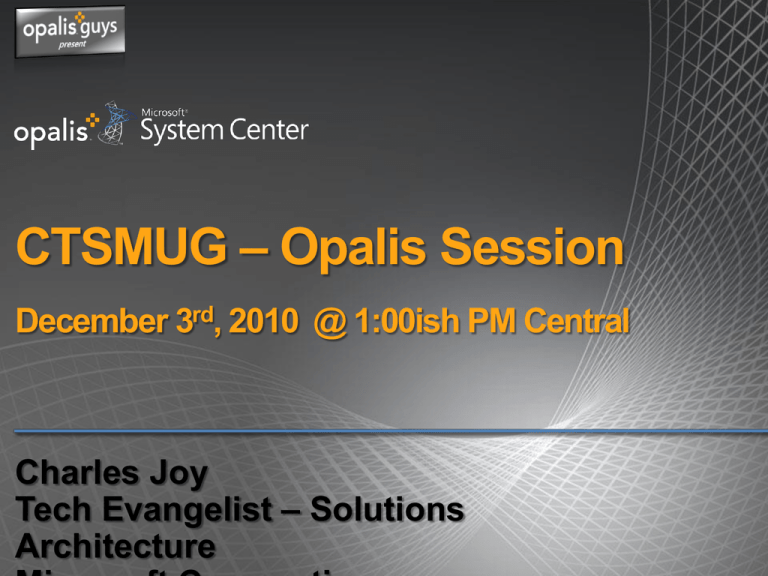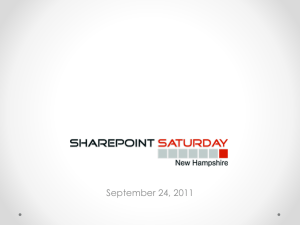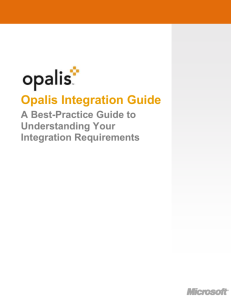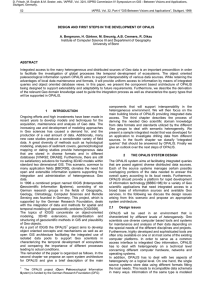
CTSMUG – Opalis Session
December 3rd, 2010 @ 1:00ish PM Central
Charles Joy
Tech Evangelist – Solutions
Architecture
Agenda
•
Opalis Product Overview
(100 Level - Sales/Marketing Focus)
•
Opalis Demo VM and Technical Overview
(200/300 Level - Technical Focus)
•
FAQ
•
Q & A (throughout)
Opalis Product Overview
Level 100 - Sales/Marketing Focus
System Center Server Management Suite
Service Manager
Remedy
Action Request System
.
OpenView Operations
What Does Opalis Do?
IT Process Automation (ITPA), also known as Run Book Automation (RBA), is the ability to
orchestrate and integrate IT management tools through workflow
Data
Protection &
Recovery
Configuration
Management
Server
Compliance
End-To-End
Monitoring
(Physical &
Virtual)
How Are Customers Using Opalis?
Incident Management
Orchestrate incident
management and resolution
Integrate across monitoring
tools, service desks, and
configuration management
databases (CMDBs)
Virtual Machine Life-Cycle
Management
Automate provisioning,
resource allocation and
retirement
Extend virtual machine
management to the cloud
Change and Configuration
Management
Scale automated configuration
across platforms and tools
Ensure reliable change with
intelligent workflow branching
Integration for some System Center Products to be released in 2010
Data Center Automation Use Cases
•
•
•
•
•
•
Virtual Life Cycle Management
User & Service Provisioning
Closed Loop Compliance
Data Refresh/Publication
Infrastructure Remediation
RBA – Task Automation
−
−
−
−
−
−
Server Maintenance
OS Maintenance
File System Maintenance
Database Maintenance
Service Maintenance
Backup/Recovery Maintenance
•
•
•
Identity Management
VDI Deployment
ITIL Facilitation
−
−
−
−
−
−
−
Incident Response
Incident Enrichment
Event Management
Problem Management
Reconciliation
Change Management
Configuration Management
CMDB Consolidation/Federation
Data Center Automation Use Cases - Explained
Virtual Lifecycle Management
Explanation
Customer Vertical
Engagement Type
Issue to Resolve
Resolution Blurb
Provisioning and Decommissioning of Virtual Machines
Banking
Production Implementation
Decrease VM sprawl
Implement Opalis to manage the VMware virtual life cycle management, end-to-end. Opalis is
used not only to provision and maintain virtual machines, it was also (most importantly) used to
deprovision virtual machines after they have expired. The workflows were built into the existing
change management process as well as a “Virtual Machine Ordering System” (something of a
Self-Service Portal).
User & Service Provisioning
Explanation
Customer Vertical
Engagement Type
Issue to Resolve
Resolution Blurb
Provisioning (Creation) of User and Service Accounts, as well as some Services (holistic
technology offerings)
Virtualization
Production Implementation
Decrease the time it takes to “onboard” and “offboard” users
Implement Opalis to manage the user provisioning and deprovisioning. Opalis is used to create
user Active Directory accounts, mailboxes, Linux accounts, add to groups, determine expiry,
make dynamic decisions on employee type, etc. An Opalis workflow can have a user fully
provisioned in a few minutes and be ready for the next user immediately using a consistent and
reliable process. The deprovision workflows are ready to remove a user’s access as needed.
Closed Loop Compliance
Explanation
Customer Vertical
Engagement Type
Issue to Resolve
Resolution Blurb
Orchestrate Server Compliance Audits, Create and Deploy Remediation Packages, Re-Audit,
Rinse, Repeat
Aerospace / Government
Proof of Concept
Keep all managed servers compliant to a technical specification
Implement Opalis to orchestrate BladeLogic to execute a compliance/analysis job, identify which
patches/security updates are missing on which targets, create a deployment package to
remediate, deploy the package (installing necessary patches/ security updates), re-run
compliance/analysis job, re-identify which patches/security updates still missing on which
targets, repeat as necessary.
Data Center Automation Use Cases - Explained
Infrastructure Remediation
Explanation
Customer Vertical
Engagement Type
Issue to Resolve
Resolution Blurb
Remediation for tools, devices, and machines within the Infrastructure. This can be restarting
services, rebooting, updating, etc.
Managed Service Provider
Production Implementation
Proactively and reactively remediate infrastructure issues
Implement Opalis to monitor for and remediate issues which have either already caused alerts, or
have the potential to disrupt service. Opalis workflows are used to both monitor for (checking
performance, capacity, errors, etc.) and remediate issues (restarting services, rebooting machines,
updating patches, etc.). The same workflows that are used to remediate issues after they are
found can be used to proactively resolve issues before they disrupt service.
RBA – Task Automation
Explanation
Customer Vertical
Engagement Type
Issue to Resolve
Resolution Blurb
Perform any automatable task from such categories as Server, OS, File System, Database, Server,
and Backup/Recovery Maintenance. This could be via Scripts, Batch Files, SQL Statements, CLI
Commands, or using native Opalis objects.
Managed Service Provider
Production Implementation
Automate/Execute simple yet powerful (and previously manual) tasks
Implement Opalis to automate/execute simple yet powerful tasks. These tasks were previously
performed manually by resources. Many different levels of access were required in combination
with many different tools, machines, and accounts requiring that access. With Opalis, only the
Opalis service account required the necessary access to the tools, machines and accounts
necessary to perform the Server, OS, File System, Database, Server, Backup/Recovery
Maintenance tasks at hand. Opalis workflows were able to execute existing scripts, batch files,
SQL statements, CLI commands as well as access and gather data from existing tools and
machines. Error reduction, improved service levels as well as adherence to a set of consistent and
reliable process were all possible after the implementation of the Opalis workflows.
Data Center Automation Use Cases - Explained
Identity Management and Infrastructure Security Management
Explanation
Customer Vertical
Engagement Type
Issue to Resolve
Resolution Blurb
Automating the tasks surrounding Identity and Infrastructure Security Management. This can be
automating anything from onboarding, off-boarding, password resets, security reporting,
enabling/disabling, security alert handling, etc.
Energy
Production Implementation
Integrate HR system to identity management system
Implement Opalis to create the connection between the HR System (Oracle Database) and the
Identity Management System (CA IDM). Opalis objects were created to form the CA IDM
Integration Pack as a services engagement for this implementation. They were then used within
workflows after database queries to extract pertinent data from the HR System to create/modify
Identity Management attributes for users. The custom Integration Pack was created in C# and
took advantage of the Web Services Interface from CA IDM).
VDI Deployment
Explanation
Customer Vertical
Engagement Type
Issue to Resolve
Resolution Blurb
Deployment of large number of Virtual Machines for end user/developer usage
Consumer
Production Implementation
Easily manage the creation and delivery of virtual machines to end users
Implement Opalis to orchestrate VMware to automatically create (from template), prepare and
distribute a large number of virtual machines, all at once. This previously manual process used to
take many, many hours; with Opalis workflows up and running, just for 4 weeks, 20K worth of
man hours were saved.
Data Center Automation Use Cases - Explained
ITIL Facilitation
Explanation
-
-
Customer Vertical
Engagement Type
Issue to Resolve
Resolution Blurb
Incident Response - Automatically responding to Incidents regardless where they originated
and then taking appropriate action
Incident Enrichment - Automatically responding to Incidents regardless where they
originated and then updating the incident record with improved information
Event Management - Automatically handling events from the infrastructure, automating the
necessary actions through resolution
Problem Management Reconciliation - Gathering and Reporting on like Incidents, Creating
Known Issues automatically (based on Incident Data), Assisting with Root Cause Analysis
(through data inspection), etc.
Change Management - Facilitating any to all aspects of Change Management, monitor for
approvals then taking action, updating Change Requests with data, closing, creating Change
Requests as needed, etc.
Configuration Management - Assisting in the facilitation of the desired Configuration tasks,
patching, CMDB related tasks, updates, etc.
CMDB Consolidation/Federation - Consolidation of disparate data sources to federate a
CMDB, enriching CMDB CI data, updating, creating, linking CIs within the CMDB, reporting
on CI status (outages, downtime, etc.)
All
Production Implementation / Proof of Concept / Demonstration
Automate/Orchestrate all aspects of the ITIL framework
Implement Opalis to automate and/or orchestrate any and all aspects of ITIL. Like any framework,
ITIL (or MOF) offers organizations the ability to improve their business with “process”. With the
inclusion of Opalis (and Service Manager or some other service desk system), the theory of
“process” can become a reality. Opalis facilitates the framework, bringing a consistent, reliable and
auditable execution of the EXACT process identified within the framework. These types of use
cases are so common (and so consistent), no one of the implementations stand out.
Video
Manual Incident Management (Before)
For Videos:
http://blogs.technet.com/b/charlesjoy/archive/2010/08/26/tech-ed-opalisit-process-automation-introduction-amp-technical-overview.aspx
Video
Automated Incident Management
(After)
For Videos:
http://blogs.technet.com/b/charlesjoy/archive/2010/08/26/tech-ed-opalisit-process-automation-introduction-amp-technical-overview.aspx
Incident Triage Process - Manual
Monitoring
Test &
Diagnostics
Service Desk 1
Service Desk 2
Infrastructure
Configuration
Management
Incident Triage With Automation
Monitoring
SD1 Incident ID
SD2 Incident ID
New Event
Details
Service Desk 1
SD2 Incident ID
SD1 Incident ID
Event Details
Fault Verification
Diagnostic Results
CI & Effected
Service Data
Service Desk 2
SD1 Incident
Details
SD2 Incident ID
Workflow + Data Bus
Diagnostic
Results
Run Diagnostic
Test &
Diagnostics
Verification
Result
Verify
Fault
Infrastructure
CI & Related
Service Data
Lookup CI
Configuration
Management
Customer Use Case
Company: Large Phonebook Company
Use Case: End to End Data Refresh of .com Data
Use Case Specifics:
• Before Opalis: ~5 Resources; Able to run twice a week
• After Opalis: 1 “On-Call” Resource when necessary;
Could run two times a day if desired
• Benefits:
− Fully Automated (unattended) Process
− Increased Customer Billing Frequency
− Resources were able to be reassigned for more important
tasks (building new Datacenter)
Customer Use Case
Use Case Specifics:
• Steps Orchestrated/Automated:
•
−
−
−
−
−
−
−
Staging Data ETL (ANT Build Process)
Server Maintenance Mode State
Database and Web Services Start/Stop
Staging Data Verification (with some desired human interaction)
SAN Processes (Deport, Copy, Clone, Import, Backup)
Network Switch Suspension/Activation
Functionality Verification
Extras:
− 100% Dynamic
− Fully User “Haultable” and “Restartable”
− Built with full verbose Error Handling and Logging
Opalis Integration Packs
Microsoft Active Directory
HP Operations for UNIX
Microsoft Systems Management Server
HP Operations Windows
Microsoft SC Operations Manager
HP Operations Solaris
Microsoft SC Configuration Manager
HP Network Node Manager
Microsoft SC Virtual Machine Manager
HP Service Desk
Microsoft SC Data Protection Manager
HP Service Manager
Microsoft SC Service Manager
HP Asset Manager
BMC Atrium CMDB
HP iLO 2
BMC Remedy AR System
Symantec VERITAS NetBackup
BMC Event Manager
IBM Tivoli Enterprise Console
BMC Patrol
IBM Tivoli Netcool/Omnibus
BMC BladeLogic Operations Manager
IBM Tivoli Storage Manager
CA AutoSys
EMC Smarts InCharge
CA eHealth
Vmware VI/ vSphere
CA Service Desk
UNIX Integration
CA SPECTRUM
CA Unicenter NSM
Why Opalis
IT Process Automation can reduce costs, simplify
management and optimize resources through:
•
•
•
•
•
Multi-vendor integration, no rip & replace or vendor
lock-in
Pre-built activities & workflow processes to speed
time to value
Publish and subscribe data bus to share data and
initiate tasks within the silos
Configuration of workflows is done without coding or
scripting
Intelligent workflows with rule-based branching
The Opalis Components
Opalis Integration Server
Workflow
Designer
11
Operator’s
Console
GUI
(Design, manage, report)
Process
Catalogs
Data Store
(Store process logic)
Automation Platform
Action Servers
(Run processes)
Integration
Packs
Policy Execution
Workflow
Designer
Operator Console
11
GUI
(Design, manage, report)
Data Store
(Store process logic)
Action Server
(Run processes)
Opalis Data Bus
Full line as a string
Full line as a string
Category
Opalis Data Bus
Demonstration
Level 200/300 - Technical Focus
Data Manipulation
Upper
• converts text to upper case
Lower
• converts text to lower case
Field
• returns text in a specific position relative to a delimiter
Sum
• returns the sum of a set of numbers
Diff
Mult
Div
Instr
Right
• returns the difference of two numbers
• returns the product of a set of numbers
• returns the quotient of two numbers
• returns the position of first occurrence of text within other text
• returns a subset of the text from the right side of the full text
Left
• returns a subset of the text from the left side of the full text
Mid
• returns a subset of the text from the middle of the full text
LTrim
• trims leading spaces from text
RTrim
• trims the trailing spaces from text
Trim
• trims leading and trailing spaces from text
Len
• returns the length of text
Related Links
http://www.microsoft.com/systemcenter/en/us/opalis.aspx
http://blogs.technet.com/b/charlesjoy/
© 2010 Microsoft Corporation. All rights reserved. Microsoft, Windows, Windows Vista and other product names are or may be registered trademarks and/or trademarks in the U.S. and/or other countries.
The information herein is for informational purposes only and represents the current view of Microsoft Corporation as of the date of this presentation. Because Microsoft must respond to changing market conditions, it
should not be interpreted to be a commitment on the part of Microsoft, and Microsoft cannot guarantee the accuracy of any information provided after the date of this presentation.
MICROSOFT MAKES NO WARRANTIES, EXPRESS, IMPLIED OR STATUTORY, AS TO THE INFORMATION IN THIS PRESENTATION.












